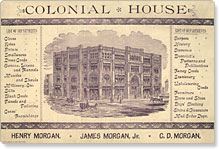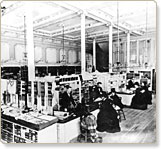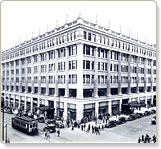|
|
The Department Store
 |
Morgan's Colonial House promotional card listing departments, 1891 |
The history of the department store is one of innovation and influence. The modern department store denotes much more than simply a broadening of the range of goods offered for sale. It also marks a fundamental shift in management organization. In addition to goods being 'classified' according to type and presented to the public accordingly, the department store management model was increasingly decentralized. Individual department managers were responsible for purchasing, price setting, promotion and sales. They were expected to meet staff salaries as well as their assigned share of store overheads from the departmental budget. Morgan's was the first retail operation in Canada to adopt this type of organization, a transition that took place during the 1870s and 80s.
Department stores first appeared in Europe and North America in the mid 19th century, more often than not evolving from dry goods establishments, i.e. businesses selling fabric, patterns, and sewing notions such as thread, ribbons and lace. Hudson's Bay Company's own evolution is somewhat different in that from the very beginning the assortment of goods carried by Hbc was wider than that of other department store antecedents: hardware, dry goods, foodstuffs, and clothing. But other retailers acquired by Hbc, such as Simpsons, Woodward's and Morgan's, do follow this pattern.
The rise of the department store was an urban phenomenon. As cities grew, larger numbers of customers dictated a broadening of items for sale. Roads and rapid transit such as trains, subways and streetcars, converged on downtown areas, concentrating populations and encouraging retailers to locate there. Location was paramount to business success: being in the "wrong" place often meant retailers were forced to move. In Calgary, the coming of the railway effectively relocated the centre of the city from the east to the west bank of the Elbow River. Left behind on the wrong side, Hbc soon followed. Sometimes a strong retailer could actually influence the development of a city. Montreal provides an illustration of this.
 |
Morgan's, St. James St. store, ca. 1890, soft goods department |
In 1866 Henry Morgan and Company was located on St. James St. at Victoria Square, then the city's financial district. By 1886 however a new generation of Morgans had entered the business and saw an opportunity in relocating to the growing residential area along Ste. Catherine St. at the top of Beaver Hall Hill. Competitors were amused and sceptical, and confidently predicted disaster. But they were proven wrong. The brand new red sandstone store on Phillips Square opened in 1891 and within five years the retail district had been effectively relocated to Ste. Catherine - where it remains to this day.
Department stores became exemplars of new trends. These large urban showcases introduced innovations in architecture and engineering, such as escalators, elevators, air conditioning, electric lighting, steel frame construction, and fire-proofing, to the general public. Large even by today's standards, many of the classic downtown stores - such as the Bay flagship stores in Montreal, Toronto, Calgary and Vancouver - were the largest stores of their time. And their economic importance was also significant: larger than many contemporary industrial complexes, in their heyday department stores were the biggest importers, the largest employers, and had the greatest sales volumes of any sector.
Thanks to the department store and its scale of operations business innovations like credit, mail order and catalogue sales, distribution chain, inventory control, visual presentation and media promotion developed rapidly. Always eager to differentiate themselves, retailers competed for customers by focusing on new services such as home delivery, in-store groceries, pharmacies and restaurants, postal and telephone services, fur storage, and recreational facilities.
The need for consistent customer service delivered by skilled staff led naturally to department stores becoming leaders in the area human resources management. Focused recruiting and on-the-job training produced highly qualified staff. Large numbers of people, and the desire to retain them, led to the development of employee benefits such as pensions, life insurance, health insurance, paid vacations and stock purchase plans.
 |
Hbc Vancouver store, 1933
HBCA 1987/363-V-115/10 |
The influence of the department store on society in general cannot be underestimated. It helped spur mass production and gave rise to the culture of consumption and "fashion". It also turned out to be a great force for social change. Credit democratized consumption by allowing those of limited means the ability to pay for purchases over time. Now, anyone could manage to acquire goods previously available only to the well-to-do. But it is democratization of another kind - namely, the development of women's rights - that is perhaps the department stores' most lasting legacy.
While shopping has traditionally been seen as the domain of women, in the 19th century it was also an activity that women could engage in on their own. Where other types of social interaction were forbidden to women, or mandated that they be accompanied by chaperones or servants, it was socially acceptable for women customers to shop alone. As department stores expanded the staffs required to run them grew as well. In 1874 Morgan's store had over 150 clerks. By the end of the century some of these positions were becoming available to women. Wartime pressures in the early 20th century accelerated employment opportunities for women in the retail sector. By the late 1930s women could pursue a professional career with a department store and financially support themselves and their families.
|
